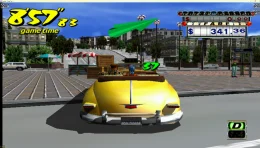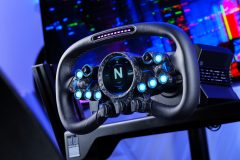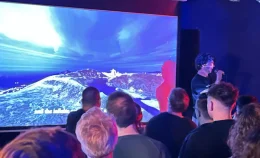I like people that set goals. Be it for themselves or the company they work for. It will make them measure progress and success, Or decline and failure of course but that’s what seperates the boys from the men. Intel CEO Brian Krzanich boldly stated that Intel chips will power 40 million tablets sold this year.
As he has no magic wand it will need other tinkering tools for Intel to get to that level. Innovative thinking, developing and producing will be his means to tinker at the helm of Intel.
And yes, Krzanich loves tinkering! Somehow it makes little difference if he’s managing Intel or helping his daughters get through science classes. To show (off?) his capabilities he helped his younger daughter build a dry-ice-powered tennis ball cannon. He’s also on the verge of building his older daughter a bedroom alarm system that can alert her if her little sister tries to make an unauthorised entry. (Or, him being a dad just like me: It might also help prevent others to get into her bedroom? I should ‘ave thought about that years ago)
Market Intrusion Detection would have been something Intel could have used a couple of years ago when Qualcomm, Nvidia and other ARM-based chip rivals were nibbling at the giant’s toe by eating “not so important” chips to be used in mere phones. That mistake made them a serious threat to a market that would never be harmed by phones and tablets: the much larger PC market. To be true: Many, like myself, wouldn’t have expected the PC-demise this early.
To make his 40 million plan to come true Krzanich is now debugging and changing a company that dominated only a few years ago but is now becoming stagnant in todays mobile market.
“Right now people look at Intel as the PC company,” Krzanich said in an interview on New Years Eve. “We did a very good job of becoming the PC company over the last 20 years or something. That was a battle worth fighting and winning, but the market moved.”
Krzanich has pushed his teams to get operational versions of products that should be hitting the market next month, or next quarter. Gadgets like wearables, ground breaking tablets, and sure, next years PC’s.
“Wearables is wide open,” said Krzanich, who spent a career on the manufacturing side of Intel before being named operating chief in January 2012 and then CEO in May 2013. “CES will show you that we are actually going to bring some very innovative wearables pretty ready to be shipped to the waiting markets.”
Intel is working on a new addition to the Quark line of chips it debuted last year. While the first Quark chips found their way into heating and air conditioning systems in Europe, Krzanich said the new chip family is likely to find a home in all manner of gear from machines to wearables and more.
“Our view is that Quark can make almost everything smart,” Krzanich said. “We’ll show you some things that you would never have thought could become smart and communicate.” Krzanich knows Intel cannot afford to remain a small player in the market for tablets and phones. That’s we he set the 40,000,000 goal and to get there he also announced plans to make Intel’s signature chips in outside manufacturing plants so they can develop more integrated processors for phones and the likes in house. Chips and integrated parts that will enable a different way of imaging for instance.
Phones, he admits, are likely to remain a challenging market for Intel to crack. “The phone space is tough because it is consolidated,” he said, noting that Apple and Samsung get 80 percent of the profits from the entire handset market. “If you really want to make inroads there you need to win one of the two big guys.”
Beyond the individual product areas, Krzanich is also on a mission to change both the way Intel thinks and the speed at which it moves.
Krzanich points to Quark as an example of how Intel will alter it’s way into the future. At the 2013 Maker Fair in Rome Intel distributed 1,500 Quark-powered circuit boards for hobbyists to make their own gear. That happened only six weeks after Krzanich and his colleagues had decided to launch the product. “The product had no name,” Krzanich said. “We didn’t have a board. We didn’t have a manufacturer. All of that got put together in six weeks….The velocity of innovation is starting to accelerate. There are still a lot of things that slow us down–how we make decisions, the number of people who feel like they have to have a say,” Krzanich said. “Those things get in our way sometimes.”
In the past, the company was looking into its own for answers, at what it was capable of and trying to push the market in their direction. Now Intel has to figure out where the market is going and what is needed in several years from now. Then it’s to go out and solve the challenges.
Krzanich has also made moves to step away from efforts that he didn’t think profitable in the mid future, like their foray into the pay TV. More about that in Imtel’s thoughts on the TV situation.)
Some have questioned if somebody that came from their own ranks, and even more so one from the manufacturing department, would be the CEO that can and should change that massive company and keep it’s reputation as an Industry leader and Innovator. Krzanich feel he and his fellow manufacturers are seen in the wrong light. Far from being boring plants run with military-like precession, Krzanich said that Intel’s labs have been hotbeds of innovation.
That was especially true in the early days, he recalls, when Intel made much of its own equipment, often incorporating hand-crafted tweaks to get the desired results. “I always tell people I grew in a maker-like community because in the lab, especially in early days half the times we would build all the equipment ourselves,” Krzanich said. “As an engineer I tended to maintain my own equipment along with developing the processes for it.”
Although a lot of these processes are now formalized and allow (or need) less improvisation the last few years, the spirit of innovation and creations is still forcibly around. What once started with hand build equipment is now replaced by tools so highly developed that they are capable of etching lines hundreds of times thinner than a human hair.
“I think of it as one of the places of greatest invention,” he said of Intel’s plans. “Every two years, to keep Moore’s Law happening, you have to invent. … That’s where I grew up.”
Krzanich will be among the speakers at our inaugural Code Conference, May 27-29 in Palos Verdes. For details on the event, including registration info, please visit our events page.
Source


















